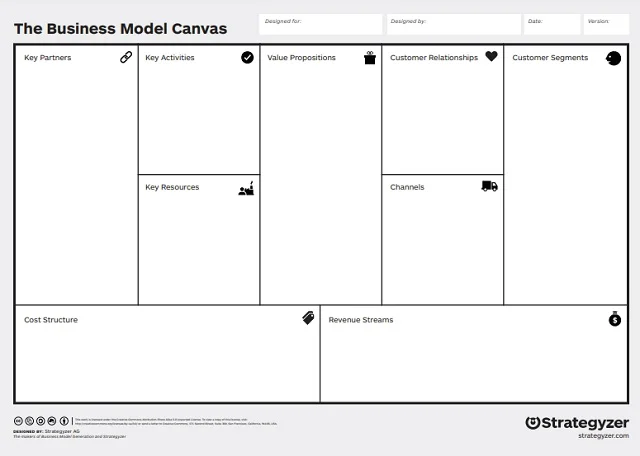Every great company is born from an idea: a solution to a problem or an answer to an unmet need. However, the path from idea to reality can be a maze of extensive business plans and complex documents. As an entrepreneur, you need an agile tool that allows you to visualize, design, and validate your business in a structured way without drowning in paperwork. This is where the Business Model Canvas becomes your best ally.
The Business Model Canvas (BMC) is a world-renowned strategic management tool. It allows you to describe, design, and pivot your business model on a single page, in an incredibly visual and collaborative way. Beyond being a simple diagram, it links directly to your company’s Strategic Plan (Ortíz & Capó, 2015), offering unprecedented clarity.
Its impact has transcended the corporate world, being used to foster an entrepreneurial mindset in students (Jamira et al., 2021) and even to develop digital policies.
In this definitive guide, we will take you step-by-step through this powerful tool. We will explore what the Canvas Model is and its purpose, break down each of its 9 blocks with key questions, show you how to make an effective Business Model Canvas, analyze examples from companies like Netflix and Spotify, and analyze the tool’s variations.
What is the Business Model Canvas?
The Business Model Canvas is a visual management tool created by Swiss author Alexander Osterwalder and Yves Pigneur in their book, “Business Model Generation.” It consists of a canvas or template divided into nine fundamental blocks that represent the key areas of a business.
Its genius lies in its simplicity. Instead of a 50-page business plan, the BMC offers you a panoramic view of how your company creates, delivers, and captures value. It’s a common language that everyone on your team can understand, allowing for quick analysis, fluid communication, and dynamic ideation.

The Business Model Canvas is a strategic tool for developing new business models or documenting existing ones (Ortíz & Capó, 2015). Likewise, the canvas follows the principle of how a company creates, captures, and delivers value (Micieta et al., 2020); and it offers a visual chart with elements that describe the value proposition, infrastructure, customers, and finances of a company or product.
Key advantages: What is the purpose of the Canvas Model?
Before diving into its components, it is crucial to understand the benefits this tool will bring to your project. Using the Canvas Model allows you to:
- Gain a holistic view: You will understand your business at a single glance, identifying the interconnection between its different parts. Kupczyk et al. (2024) state that the Business Model Canvas is valued for its ability to bring clarity and visualization to business concepts and that it facilitates a comprehensive view of operations by mapping crucial elements such as value propositions, customer segments, and revenue streams.
- Improve communication: It facilitates the discussion of ideas and collaboration among team members, partners, and investors. Everyone works from the same map.
- Foster innovation: Its visual and flexible format encourages experimentation. You can test different business models simply by moving post-it notes from one place to another.
- Identify weaknesses and opportunities: Seeing the big picture helps you detect inconsistencies, potential risks, and new opportunities for revenue or collaboration.
- Accelerate the planning process: It is an agile tool, perfect for startups and established companies that need to adapt quickly to market changes. The research findings of Sadikin et al. (2023) highlight that the Business Model Canvas provides flexibility in long-term business planning, focuses attention on the key points of business planning, and allows companies to update existing models or elements according to the situation.
- Enhance business sustainability: Nyoman (2024) highlights that using Business Model Canvas (BMC) analysis has proven to be an effective instrument for formulating business sustainability strategies.
A study developed by Ladd (2018) explored the effectiveness of the Business Model Canvas in teams that competed in a business launch competition. The researcher determined that teams that used the customer segment, value proposition, key activities, or key partnerships elements performed significantly better.
However, like any tool, the Business Model Canvas has advantages and disadvantages. In Table 1, we highlight some of them based on the study by Becker and Bröcker (2021) and other publications.
Table 1. Advantages and disadvantages of the Business Model Canvas.
| Advantages | Disadvantages |
|---|---|
| Simple, fast, and clear documentation of the business model | Simplified model, so the level of information differs from a classic business plan |
| Less time required for creation | The demarcation between individual perspectives is sometimes difficult |
| Intuitively understandable | End customers (customers of the customers) are not taken into account |
| Easily readable and customizable | Competition is not considered |
| Promotes teamwork and collaboration | Lacks environmental analysis |
| Allows for flexible and creative work | Trends are not taken into account |
| Interrelationships are clearly evident | The representation of very complex networks is only possible with difficulty due to the intended simplicity |
| Iteration allows for step-by-step modeling of the business | As the sole instrument for the operational implementation of the business model, it is not sufficient |
| Good basis for preparing a business plan | Relevant legal frameworks are not taken into account |
| Strong customer and value proposition orientation | The company’s vision or purpose is not explicitly documented |
| Ensures a holistic view and focus on relevant business aspects | The market and its environment are not presented |
| Can be used in the different phases of a product’s life cycle | Does not provide information for monitoring business performance or making decisions about necessary changes. |
| Clear representation of the mutual dependencies between the model’s individual components | Must be updated frequently. |
| Focus on the core basic components and essential aspects of the business model: offering, customer, infrastructure, and financial structure. | |
| Prioritized and focused on the core competencies of the business model | |
| Promotes awareness of process dependencies and the effects of change | |
| Ideas can be documented directly and without formalization |
Source: Becker & Bröcker (2021); Lopes et al. (2023); Kupczyk et al. (2024).
The 9 blocks of the Business Model Canvas explained
The heart of the canvas is its nine modules. Below, we break down each one, including the key questions you should answer to fill them out.
Customer segments
For whom are we creating value? Who are our most important customers? Without customers, there is no business. Here you must define the different groups of people or organizations your company targets.
- Guiding questions:
- Are they a mass market, a niche market, a segmented market, or a diversified one?
- What are their demographic and psychographic characteristics?
- What problems or needs are we solving for them?
Value propositions
What value do we deliver to the customer? What problem are we helping to solve? This is the reason why customers choose you and not the competition. It is the bundle of products or services that create value for a specific customer segment. In this regard, Bachmann et al. (2025) indicate that it can be differentiated into three elements: economic value, social value, and environmental value, which aligns business objectives with the principles of sustainable development.
- Guiding questions:
- What makes our offer unique? Novelty, performance, design, price, convenience?
- What customer needs are we satisfying?
- How does our solution differ from existing ones?
Channels
How do we communicate with and reach our customer segments to deliver our value proposition? Channels are the customer touchpoints, and they play a crucial role in their experience.
- Guiding questions:
- Through which channels do our customers want to be reached? (e.g., physical store, website, sales team, social media).
- How are our channels integrated? Are they cost-effective?
- Which phases do they cover? (Awareness, evaluation, purchase, delivery, after-sales).
Customer relationships
What type of relationship does each customer segment expect us to establish and maintain with them? This can range from an automated and personal service to exclusive personalized assistance.
- Guiding questions:
- Is the relationship personal assistance, self-service, online communities, co-creation?
- How do we acquire, retain, and grow customers?
- What is the cost of maintaining these relationships?
Revenue streams
For what value are our customers willing to pay? This represents the money the company generates from each customer segment. It is the cash flow the company receives.
- Guiding questions:
- How do they currently pay? How would they prefer to pay?
- Does our revenue come from a one-time payment, subscriptions, licensing, advertising?
- How much does each revenue stream contribute to the total?
Key resources
What key resources do our value proposition, channels, and customer relationships require? They are the most important assets required for the business model to work.
- Guiding questions:
- Do we need physical resources (machines, facilities), intellectual (patents, brands), human (experts), or financial (lines of credit)?
- What resources are indispensable to deliver the promised value?
Key activities
What key activities must we perform for our business model to work? They are the most important actions a company must undertake to operate successfully.
- Guiding questions:
- Are our key activities production, problem-solving (consulting), or platform/network management?
- What actions are crucial for our value proposition and revenue generation?
Key partnerships
Who are our key partners? Who are our key suppliers? It is the network of suppliers and partners that make the business model work. Strategic alliances can optimize the model, reduce risks, or acquire resources.
- Guiding questions:
- Who are our strategic partners? (Not suppliers).
- What partnerships are critical to our success?
- What are the motivations for these partnerships? (Optimization, risk reduction, resource acquisition).
Cost structure
What are the most important costs inherent to our business model? It describes all costs incurred to operate. Resources, activities, and key partnerships all have a cost.
- Guiding questions:
- What are the most significant costs? Are they fixed or variable?
- Is our business model cost-driven (minimize expenses) or value-driven (offer a premium proposition)?
- Can we achieve economies of scale or scope?
How to make a Business Model Canvas step-by-step
Creating your canvas is a practical and collaborative exercise. Follow these steps for an effective result:
- Gather your team: Invite people from different areas of your company (marketing, finance, operations). A diversity of perspectives enriches the result.
- Get a large canvas: Print the Business Model Canvas in a large format (A1 or A0) and stick it on a wall. If you work remotely, use online tools like Miro or Mural.
- Use post-it notes and markers: The idea is for it to be flexible. Write a single idea per post-it and stick it in the corresponding block. Use different colors for different customer segments or ideas.
- Start with customers and the value proposition: It is generally easier to start on the right side of the canvas (customers, proposition, channels) before moving to the left side (resources, activities).
- Map your current situation: If you already have a business, start by describing your current business model. This will give you a solid foundation.
- Question and connect: Once you have ideas in all the blocks, start connecting the dots. Does your value proposition really fit your customer segment? Are your channels appropriate? Does your revenue cover your costs?
- Ideate new models: Don’t stick with the first version. Use the canvas to explore new possibilities. What would happen if you changed your main customer segment? What if you offered your product as a subscription?
Examples of the Business Model Canvas in action
To better understand its power, let’s see how the canvas would be applied to two well-known companies.
Business Model Canvas example: Netflix
- Customer segments: Global mass market. People looking for on-demand, ad-free entertainment.
- Value proposition: Unlimited access to a vast catalog of movies, series, and documentaries from any device, at an affordable monthly price, and with exclusive original content.
- Channels: Website, apps for smart TVs, consoles, mobile phones, and tablets.
- Customer relationships: Self-service through the platform, personalized recommendation system (algorithm).
- Revenue streams: Monthly subscription plans (basic, standard, premium).
- Key resources: Licensed and original content (its greatest asset), the technology platform, the recommendation algorithm.
- Key activities: Content production and acquisition, platform maintenance and development, content marketing.
- Key partnerships: Content producers, film studios, Internet Service Providers (ISPs), device manufacturers.
- Cost structure: Massive costs for content production and licensing, marketing and advertising, technological development, and data infrastructure.
Business Model Canvas example: Spotify
- Customer segments: Music users (freemium model) and premium subscribers (who pay for extra features). Artists and record labels.
- Value proposition: For users: access to millions of songs for free (with ads) or unlimited and offline (premium). For artists: a platform to reach millions of listeners.
- Channels: Desktop and mobile apps, website, integrations with other devices (speakers, cars).
- Customer relationships: Self-service, personalized playlists, and automated music discovery.
- Revenue streams: Premium subscriptions and advertising for free users.
- Key resources: Licensed music catalog, the Spotify brand, the technology platform, and its algorithms.
- Key activities: Platform development, negotiating licenses with record labels, selling advertising.
- Key partnerships: Record labels, artists, podcasters, advertisers.
- Cost structure: Royalties paid to rights holders (the largest cost), software development, marketing.
Limitations of the Canvas and how to overcome them
Although the Business Model Canvas is an exceptional tool, it is not perfect. It is vital to know its limitations to use it intelligently.
- Internal focus: The canvas focuses mainly on the company and does not explicitly include analysis of the competition or the market environment (PESTEL factors).
- Solution: Complement the Canvas with a SWOT analysis and a competitor analysis to get a 360° view.
- Static nature: A completed canvas is a snapshot of a specific moment. Markets and strategies change. According to Lopes et al. (2023), entrepreneurs tend to adopt the business model canvas if they perceive their market to be static.
- Solution: Treat your Canvas as a living document. Review and update it quarterly or whenever there is a significant change in your business or the market.
- Lack of operational detail: It does not delve into the ‘how’ of implementing key activities or internal processes. In this regard, Rispianda et al. (2025) developed a mathematical model to, for example, make the decision to bring a product to market.
- Solution: Use Canvas as a starting point to develop more detailed action plans, process maps, or project plans.
- Emphasis on the ‘What’ and not the ‘Why’: It does not focus as much on validating whether the customer’s ‘problem’ is real, which is crucial for very early-stage startups. Kupczyk et al. (2024) highlight that the business model canvas framework sometimes requires assumptions about customer behavior, market conditions, and partnerships, which are not always met in practice, emphasizing the need for continuous validation and refinement.
- Solution: For this, the Lean Canvas is often a better initial alternative.
Variations of the Business Model Canvas
The Canvas has become one of the most widely used tools in business modeling. In this regard, various researchers have proposed variations or modifications to use the business model for social innovation, to highlight business sustainability, the circular economy, digital government, among others.
Currently, the circular economy is being promoted as a response to the problems generated by waste generation; in this sense, Daou et al. (2020) propose the “Ecocanvas” as a tool to rethink and customize sustainability and the circular economy.

Sparviero (2019) introduced the Social Enterprise Model Canvas (SEMC), a business model conceived to design organizational scenarios for social enterprises, to solve the paradox of mission measurement, and to face the challenges of strategy, legitimacy, and governance.
For their part, Joyce and Paquin (2016) propose the triple-layered business model canvas as a tool to explore sustainability-oriented business model innovation. The researchers enhance the canvas model by adding two layers: an environmental layer based on a life cycle perspective, and a social layer based on a stakeholder perspective.
Capturing the symbolic value of an artist is difficult using the Business Model Canvas; in this regard, Carter and Carter (2020) present a modification of the business canvas to capture the value proposition of the creative arts, for use by visual artists and social arts enterprise organizations where the notion of value can be difficult to articulate.
Rose et al. (2019) developed a methodological tool to assist in the design and development of innovative digital services; the tool was based on the Business Model Canvas.
Conclusion
The Business Model Canvas has proven to be much more than a passing fad. It is a fundamental tool for entrepreneurs and managers seeking clarity, agility, and a common language to talk about what really matters: how to create value.
By filling out its nine blocks, you are not just creating a plan, but you are starting an ongoing strategic conversation. Remember that it is a living document, designed to evolve with you and your business. The use of graphics makes it easy to understand the entire business just by looking at the canvas.
However, the Business Model Canvas also has some disadvantages that are good to know when using the tool, in order to complement it with other tools to have a better overview for decision-making.
It is important to emphasize that the canvas should not be seen as a static document; it is a dynamic tool that facilitates business planning. Likewise, the business model canvas can help you innovate, especially the disruptive kind.
Now you have all the information you need. It’s your turn to take a canvas, arm yourself with post-it notes, and start designing, questioning, and building the future of your company.
References
Bachmann, N., Thienemann, A., Tüzün, A., Brunner, M., Tripathi, S., Pöchtrager, S., & Jodlbauer, H. (2025). The Evolution of the Business Model Canvas for Digital Sustainability. Procedia Computer Science, 253, 1012-1023. https://doi.org/10.1016/j.procs.2025.01.163
Becker, Marco; Bröcker, Jan-Oliver (2021). Business Model Canvas Overview of the main advantages and disadvantages, IUCF Working Paper, No. 6/2021, ZBW Leibniz Information Centre for Economics, Kiel, Hamburg.
Carter, M. and Carter, C. (2020), “The Creative Business Model Canvas“, Social Enterprise Journal, Vol. 16 No. 2, pp. 141-158. https://doi.org/10.1108/SEJ-03-2019-0018
CFI. 2022. Business Model Canvas Template
Daou Alain, Camille Mallat, Ghina Chammas, Nicola Cerantola, Sammy Kayed, Najat Aoun Saliba. 2020. The Ecocanvas as a business model canvas for a circular economy, Journal of Cleaner Production, Volume 258, 2020, 120938, ISSN 0959-6526, https://doi.org/10.1016/j.jclepro.2020.120938.
Jamira, A., Agustiningsih, N., & Febriani, Y. (2021). THE IMPLEMENTATION OF BUSINESS MODEL CANVAS (BMC) TO IMPROVE STUDENTS’ ENTREPRENEURSHIP MINDSET. Dinasti International Journal of Education Management And Social Science, 2(3), 395-403. https://doi.org/10.31933/dijemss.v2i3.751
Joyce Alexandre, Raymond L. Paquin. 2016. The triple layered business model canvas: A tool to design more sustainable business models. Journal of Cleaner Production,
Volume 135, 2016, Pages 1474-1486, ISSN 0959-6526, https://doi.org/10.1016/j.jclepro.2016.06.067.
Kupczyk, T., Dewalska-Opitek, A., Witczak, O., Budziński, M., & Kalita, D. (2024). Business model canvas application in start-up stage business developments : constraints and challenges. European Research Studies Journal, 27(4), 921-940.
Ladd, T. (2018), “Does the business model canvas drive venture success?“, Journal of Research in Marketing and Entrepreneurship, Vol. 20 No. 1, pp. 57-69. https://doi.org/10.1108/JRME-11-2016-0046
Lopes, H. E. G., Rodrigues, V. C., Leite, R. S., & Gosling, M. (2023). Business Model Canvas and Entrepreneurs: Dilemmas in Managerial Practice. BBR. Brazilian Business Review, 20(3), 260-280.
Micieta Branislav, Miroslav Fusko, Vladimira Binasova, Beata Furmannova. 2020. Business model canvas in global enterprises. SHS Web Conf. 74 02010 (2020). DOI: 10.1051/shsconf/20207402010
Nyoman Sawitri, N. (2024). Business Sustainability Strategy: A Business Model Canvas Approach. Siber International Journal of Digital Business (SIJDB), 2(2), 104–116. https://doi.org/10.38035/sijdb.v2i2.90
Ortiz B. y J. Capó. 2015. 10 pasos para desarrollar un plan estratégico y un Business model canvas. 3c Empresa: investigación y pensamiento crítico, ISSN-e 2254-3376, Vol. 4, Nº. 4, 2015 (Ejemplar dedicado a: 3C Empresa – Edición Nº 24), págs. 231-247
Rispianda, R., Subagyo & Darmawan, A. Optimising the business model canvas to determine time to market through concurrent product development. Prod. Eng. Res. Devel. 19, 695–717 (2025). https://doi.org/10.1007/s11740-025-01334-1
Rose Jeremy; Holgersson Jesper; and Söderström Eva (2019). “DESIGNING INNOVATIVE DIGITAL SERVICES FOR GOVERNMENT: A BUSINESS MODEL CANVAS ADAPTATION“. In Proceed ngs of the 27th European Conference on Informat on Systems (ECIS) Stockholm & Uppsala Sweden June 8 14 2019. ISBN 978 1 7336325 0 8 Research Papers. https://a sel.a snet.org/ec s2019 rp/11
Sadikin, A., Naim, S., Asmara, M. A., Hierdawati, T., & Boari, Y. (2023). Innovative strategies for MSME business growth with the business model canvas approach. Enrichment : Journal of Management, 13(2), 1478-1484. https://doi.org/10.35335/enrichment.v13i2.1421
Sparviero Sergio. (2019) The Case for a Socially Oriented Business Model Canvas: The Social Enterprise Model Canvas, Journal of Social Entrepreneurship, 10:2, 232-251, DOI: 10.1080/19420676.2018.1541011
Editor and founder of “Innovar o Morir” (‘Innovate or Die’). Milthon holds a Master’s degree in Science and Innovation Management from the Polytechnic University of Valencia, with postgraduate diplomas in Business Innovation (UPV) and Market-Oriented Innovation Management (UPCH-Universitat Leipzig). He has practical experience in innovation management, having led the Fisheries Innovation Unit of the National Program for Innovation in Fisheries and Aquaculture (PNIPA) and worked as a consultant on open innovation diagnostics and technology watch. He firmly believes in the power of innovation and creativity as drivers of change and development.





